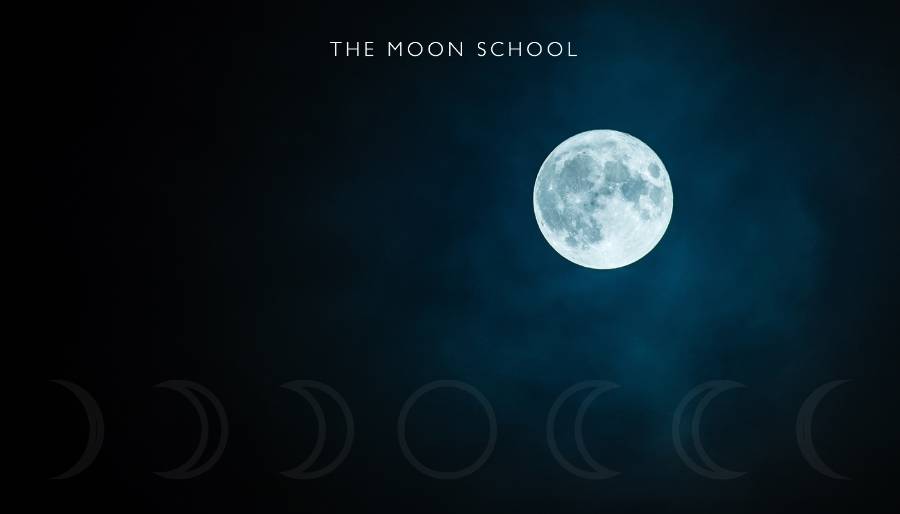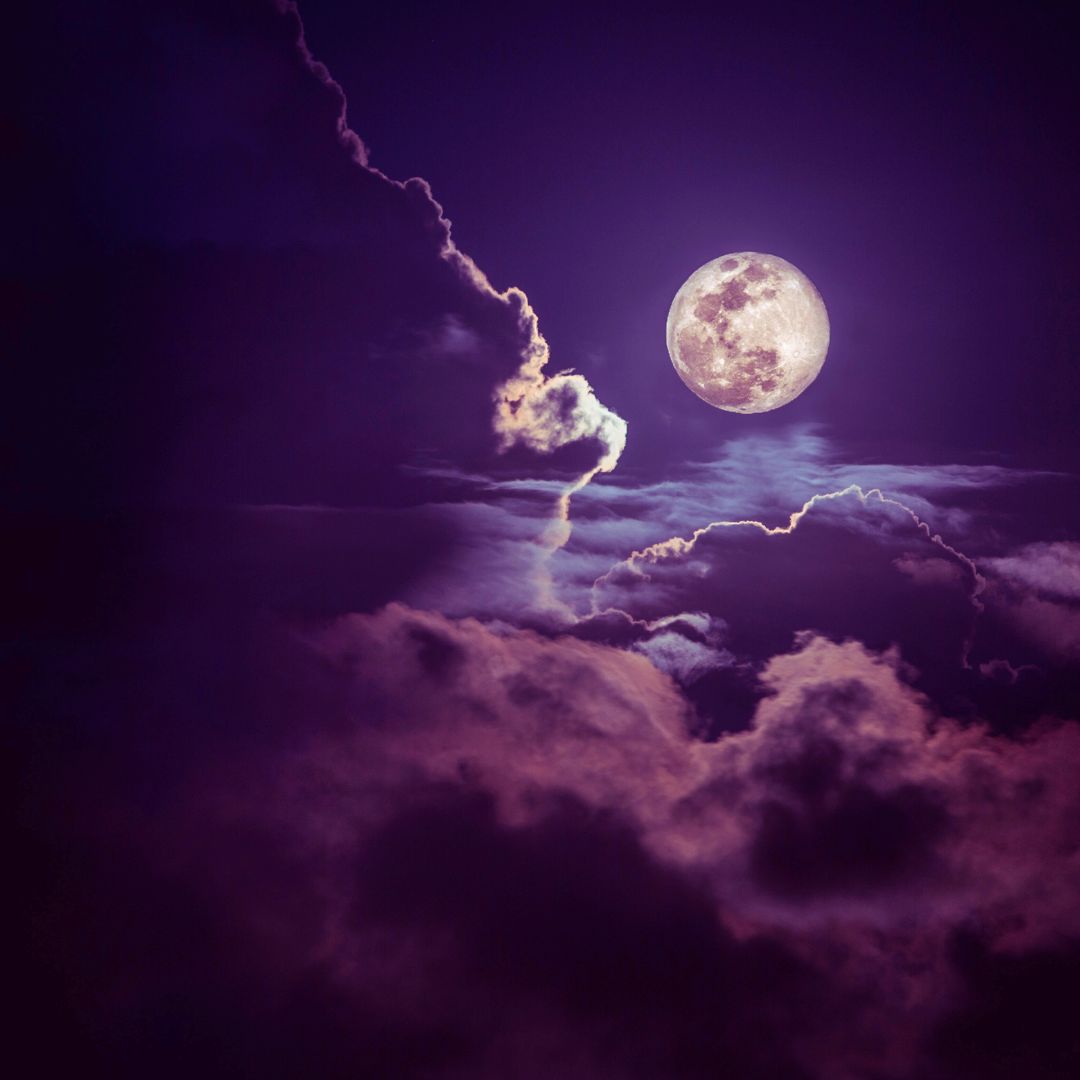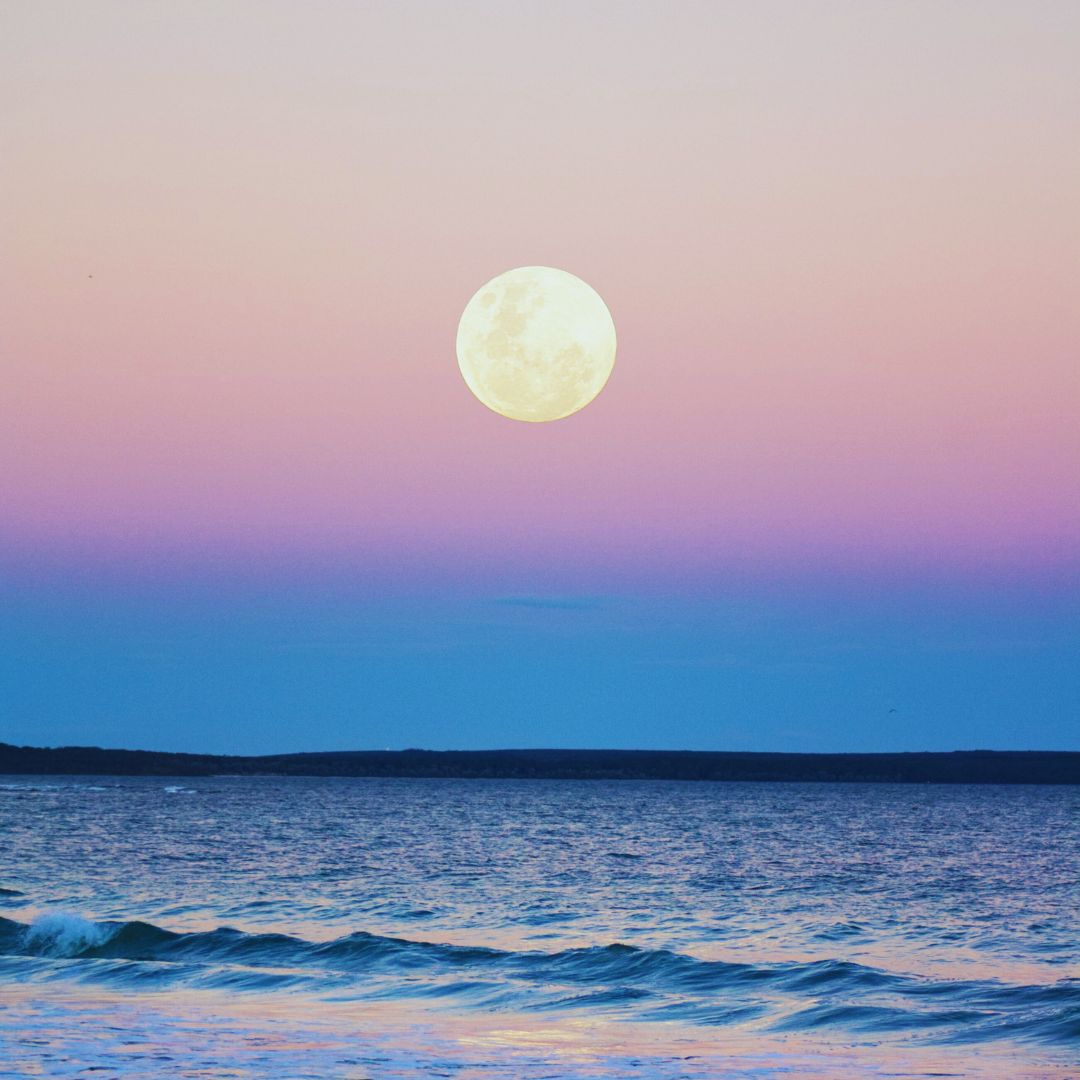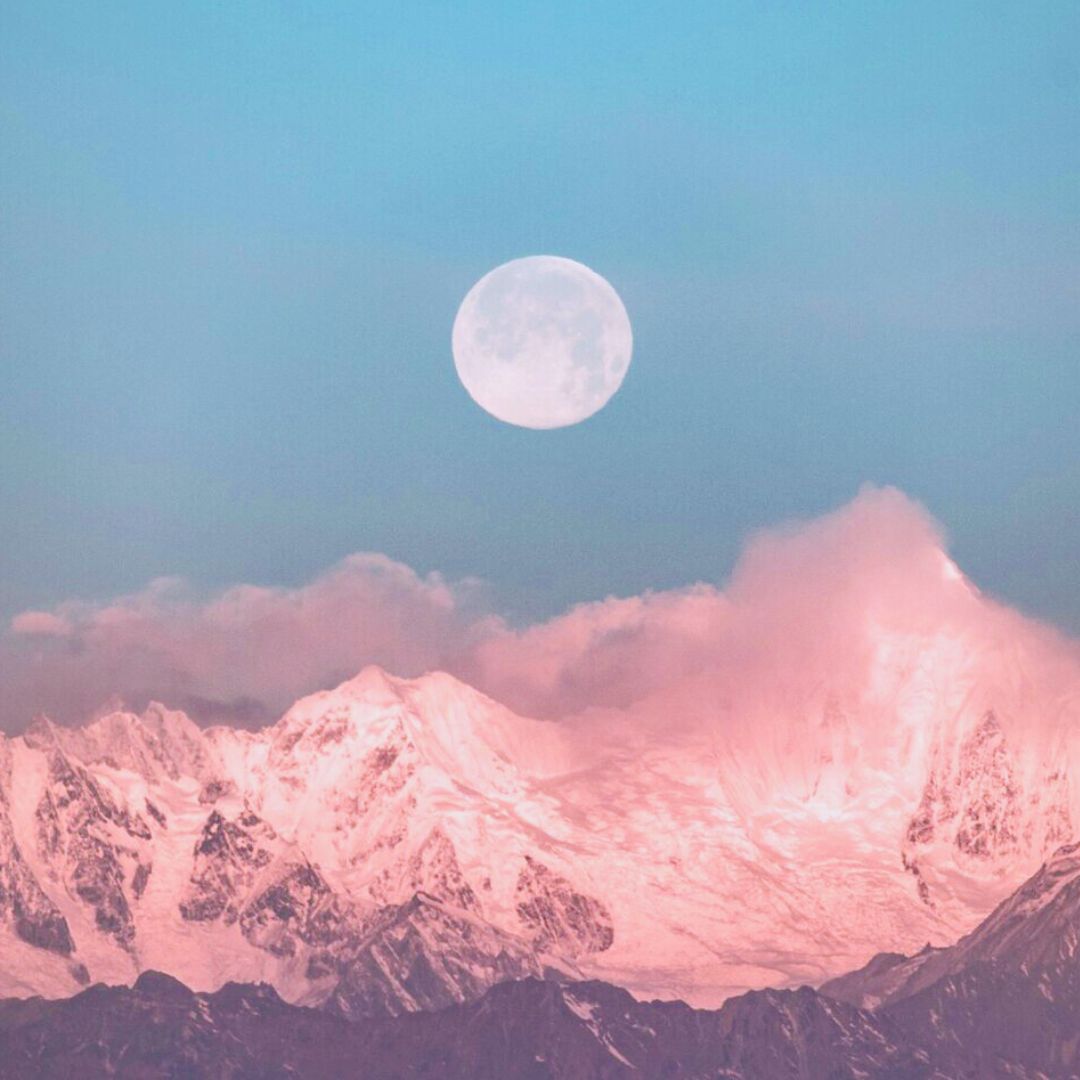Full Moons are a marvel. Captivating humans since there have been humans on Earth, the full Moon is the most recognizable and striking of all lunar phases. But if you don’t track the Moon’s phases then this beautiful bright Moon phase can take you by surprise, meaning you’ll miss out on the opportunity to work with its energy and maximize on its gifts.
So let’s get back to the basics of how often a full Moon happens, and why. We’ll also look at the fascinating array of Moon names, plus the Moon dates so you know when to plan for.
What is a full Moon?
A full Moon occurs when the Moon is positioned directly opposite the Sun, with the Earth in between.
This alignment results in the entire illuminated side of the Moon being visible from Earth, which appears as a striking and radiant disc of light in the night sky. This is caused by sunlight being reflected from the Moon’s surface, as the Moon itself has no light source.
The appearance of a full Moon in the night sky marks a significant phase in the lunar cycle, symbolizing completion and illumination. From this point onwards, the Moon will wane as its surface reflects less and less light.
Also read: What Does the Moon Mean in Astrology?
Why does a full Moon occur?
A full Moon occurs when the Moon is positioned directly opposite the Sun from the perspective of Earth. This alignment allows the entire illuminated side of the Moon to be visible. The phenomenon happens because of the Moon’s orbit around the Earth, as well as the Earth’s orbit around the Sun.
When the three bodies align in a straight line, with the Earth in the middle, the Moon appears fully illuminated from our vantage point.
It’s an intricate and eternal dance between three celestial bodies: the Earth, the Moon, and the Sun. As the Moon moves along its 29.5-day orbit, its position relative to the Earth and the Sun keeps changing, which causes the amount of sunlight reflecting off its surface to vary. This creates the phases of the Moon. These are:
New moon: The new Moon marks the beginning of the lunar cycle. At this phase, the Moon rises and sets with the Sun, making the new Moon invisible in the sky.
Waxing crescent: The waxing crescent Moon has a very thin crescent shape, rising during the daytime and setting in the western evening sky.
First quarter: The first quarter Moon forms an astrological square with the Sun, this phase is revealed as a clear “half Moon” shape. Light will expand, overtaking the dark quarter.
Waxing gibbous: When the waxing gibbous Moon occurs, she is closer to the full Moon phase than to the new. This waxing gibbous Moon appears as a blossoming disc of light, illuminated from the right in the northern hemisphere, and the left in the south.
Full moon: At the Full Moon, the Moon and Sun sit on opposite sides of Earth. Halfway through the Moon’s orbit, she’s fully illuminated and present in the sky all night long.
Waning gibbous: Past the cycle’s climax, the waning gibbous Moon phase is almost a mirror image of the waxing gibbous – a swollen round disc ebbing away from one edge.
Last quarter: The last quarter Moon (also known as the third quarter Moon) forms another astrological square with the Sun and appears as a clear “half Moon” shape. At the last quarter Moon, though, dark will overtake the light.
Waning crescent: The waning crescent Moon (or balsamic Moon) is closer to the next new Moon, than to this cycle’s full Moon. It appears as an ebbing, almost disappearing arc in the western sky.
Dark Moon: The dark Moon appears between one and three days before the new Moon, and is invisible. During the dark Moon, la Luna rises with the Sun, but is bleached out by sunlight, and absent completely from the night sky.
When the Moon is positioned directly opposite the Sun, with the Earth in between, the Sun’s rays fully illuminate the side of the Moon facing Earth, creating the mesmerizing sight of a full Moon.
This alignment, known in astrology as opposition, occurs approximately every 29.5 days, marking the peak of one lunar cycle.
How often does a full Moon occur?
Full Moons occur roughly every 29.5 days, or a little over every every four weeks. This is how long it takes the Moon to travel through one complete lunar phase cycle, and it means there’s a little over one full Moon for almost each calendar month.
How many times a year does a full moon happen?
In a typical calendar year, there are around 12 to 13 full moons, occurring approximately once every 29.5 days. While most months feature a single full moon, there are occasions when a calendar month hosts two full moons.
This phenomenon, known as a “blue moon,” is a pretty rare event that adds an element of intrigue to the lunar cycle. For some it provides an extra boost of lunar energy that is available for magical and healing work.
How long does a full moon actually last?
A full moon technically lasts for just a few moments, as the Moon reaches the point where it’s directly opposite the Sun from the perspective of Earth. However, the full Moon phase can last up to three days, during which the lunar surface still appears to be fully illuminated.
The full Moon sits between the waxing gibbous phase and the waning gibbous phase.
When is the next full Moon?
Here’s a full Moon calendar for 2024, describing the date and name of each full Moon.
- January 25, 2024: Wolf Moon
- February 24, 2024: Snow Moon
- March 25, 2024: Worm Moon
- April 23, 2024: Pink Moon
- May 23, 2024: Flower Moon
- June 21, 2024: Strawberry Moon
- July 21, 2024: Buck Moon
- August 19, 2024: Sturgeon Moon
- September 17, 2024: Harvest Moon
- October 17, 2024: Hunter Moon
- November 15, 2024: Beaver Moon
- December 15, 2024: Cold Moon
Full Wolf Moon: January 2024
The very first full Moon of the year will rise on Thursday, January 25, 2024, at 11: 57 UTC, at 5º of Leo
The January Full Moon is often known as the Wolf Moon. This name may have Celtic and Old English origins and was brought to North America by European settlers.
Other names for the Wolf Moon: Old Moon, Quiet Moon, Ice Moon, Severe Moon
Also read: Full Wolf Moon January 2024: Here’s Everything You Need to Know
Full Snow Moon: February 2024
The second full Moon of the year will rise on Saturday, February 24, 2024, at 12:30 UTC, at 5º of Virgo
The February Full Moon is often known as the Snow Moon. It’s believed to earn its name from the heavy snowfall that typically occurs in the northern hemisphere at this time.
Other names for the Snow Moon: Storm Moon, Hunger Moon, Bear Moon
Read this post next: How to Create a Full Moon Ritual for Manifesting
Full Worm Moon: March 2024
The third full Moon of the year will rise on Monday, March 25, 2024, at 07:00 UTC, at 5º of Libra and will also be a penumbral lunar eclipse.
The March Full Moon is often known as the Worm Moon. According to The Old Farmer’s Almanac, at this time of year, the ground begins to soften enough for earthworm casts to reappear.
Other names for the Worm Moon: Sugar Moon, Sap Moon (after the tapping of maples), Chaste Moon, Death Moon, Crow Moon
Full Pink Moon: April 2024
The fourth full Moon of the year will rise on Tuesday, April 23, 2024, at 23:48 UTC, at 4º of Scorpio.
The April Full Moon is often known as the Pink Moon. It’s thought that the name of the pink Moon originates with some Native American tribes. It describes the dusky pink colour of the phlox wildflowers that bloom at this time of year.
Other names for the Pink Moon: Egg Moon, Fish Moon, Budding Moon, Seed Moon, Awakening Moon
Also read: How to Moon Gaze
Full Flower Moon: May 2024
The fifth full Moon of the year will rise on Thursday, May 23, 2024, at 13:52 UTC, at 2º of Sagittarius.
The May Full Moon is often known as the Flower Moon. It’s thought that the name derives from the fact that the May Full Moon coincides with the blooming of many wildflowers in Northern America.
Other names for the Flower Moon: Hare Moon, Milk Moon, Mothers Moon, Bright Moon, Grass Moon
Full Strawberry Moon: June 2024
The sixth full Moon of the year will rise on Saturday, June 22, 2024, at 01:07 UTC, at 1º of Capricorn
The June Full Moon is often known as the Strawberry Moon. It likely earned the name, as it often coincides with the peak of the strawberry harvesting season for tribes in North America.
Other names for the Strawberry Moon: Rose Moon, Red Moon, Honey Moon, Hoe Moon and Planting Moon, Mead Moon, Horse Moon, Planting Moon.
You may also like: When is the Best Time to Manifest With the Moon?
Full Buck Moon:July 2024
The seventh full Moon of the year will rise on Sunday, July 21, 2024, at 10:16 UTC, at 29º of Capricorn
The July Full Moon is often known as the Buck Moon. It’s believed the name comes from the male deer, or buck, which begins to grow its new antlers around the same time of year that this Full Moon rises.
Other names for the Buck Moon: Deer Moon, berry Moon, raspberry Moon, Thunder Moon, Salmon Moon, Hay Moon, Herb Moon
Full Sturgeon Moon: August 2024
The eighth full Moon of the year will rise on Monday, August 19, 2024, at 18:25 UTC, at 27º of Aquarius, and is also a super Moon.
The August Full Moon is often known as the Sturgeon Moon. It likely receives the name from certain Native American tribes along the eastern coastline and Great Lakes region, where large sturgeon fish would typically be most easily caught around this lunar phase.
Other names for the Sturgeon Moon: Grain Moon, Corn Moon, Red Moon, Lightening Moon
You may also like… How to Make and Use Moon Water
Full Harvest Moon: September 2024
The ninth full Moon of the year will rise on Wednesday, September 18, 2024, at 02:45 UTC, at 25º of Pisces and is also a partial lunar eclipse.
The September Full Moon is often known as the Harvest Moon. This is the full Moon that falls nearest to the autumnal equinox, and is known as the “Harvest Moon” because its light allows farmers to work later into the night. Its bright light would assist with the last harvesting tasks before the arrival of fall.
Other names for the Harvest Moon: Grain Moon, Corn Moon, Barley Moon
Full Hunter’s Moon: October 2024
The tenth full Moon of the year will rise on Thursday, October 17, 2024, at 11:26 UTC, at 24º of Aries and is also a super Moon.
The October Full Moon is often known as the Hunter’s Moon. According to the Old Farmer’s Almanac, the name derives from its proximity to the prime early autumn deer hunting season.
Other names for the Hunter’s Moon: Seed Fall Moon, Drying Rice Moon, Falling Leaves Moon, Freezing Moon, Blood Moon, Sanguine Moon
Full Beaver Moon: November 2024
The eleventh and penultimate full Moon of the year will rise on Friday, November 15, 2024, at 21:28 UTC, at 24º of Taurus and is also a super Moon.
The November Full Moon is often known as the Beaver Moon. The name is thought to derive from certain Native American tribes, who note this as the time of year when beavers became very active in preparation for winter.
Other names for the Beaver Moon: Feezing Moon, Frost Moon, Mourning Moon
Full Cold Moon: December 2024
The final full Moon of the year will rise on Sunday, December 15, 2024, at 09:01 UTC, at 23º of Gemini.
The December Full Moon is often known as the Cold Moon. It’s thought the name derives from its timing, which is deep in winter when cold weather has set in for most locations.
Other names for the Cold Moon: Hail Moon, Long Night Moon, Oak Moon
Get the Complete Full Moon Calendar 2024: All the Full Moons in 2024
What is a Blue Moon?
The term “blue moon” refers to the second full moon that occurs in a calendar month. Because the lunar cycle isn’t exactly 30 days, most calendar months only have one full Moon.
However on occasion two full Moons will fall in in the same month. The second full Moon of the month is then referred to as a blue Moon. Blue Moons hapen around every 2.5 years.
When is the next blue Moon?
The next blue moon will occur on Sunday, May 31, 2026, at 08:44 UTC, at at 9º of Sagittarius.
What is a lunar eclipse?
A lunar eclipse occurs when the Earth comes exactly between the Sun and the Moon, causing the Earth’s shadow to fall on the Moon. This celestial event can result in the Moon taking on a reddish hue, often referred to as a “blood moon.”
Lunar eclipses can have varying degrees of exactitude, ranging from the total lunar eclipse to the partial lunar eclipse, to the penumbral lunar eclipse, when the Moon passes through only the feintest, outer part of the Earth’s shadow.








